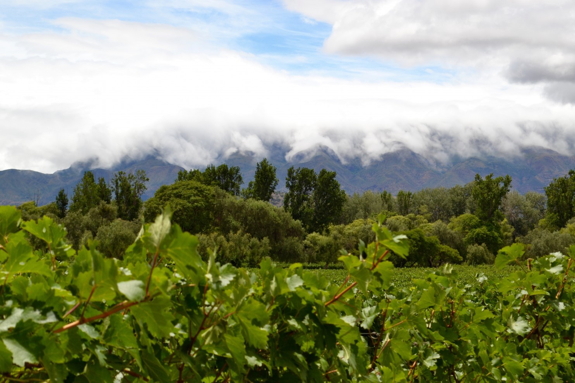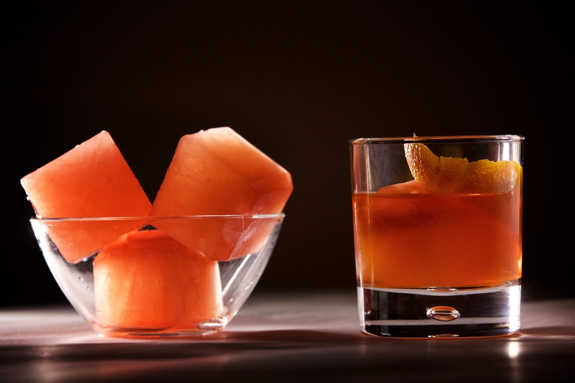
(above) The Chufly cocktail: singani, ginger ale and a lime wedge. (Deb Lindsey/For The Washington Post)
Recipe for chufly: https://www.washingtonpost.com/pb/recipes/singroni/15079/
The absolutely delicious Bolivian spirit all drinkers need to know
January 3, 2016 - The Washington Post
by M. Carrie Allan, Columnist, Food
For director Steven Soderbergh, the bottle of singani — presented to him in 2007 by the Bolivian casting director for his movie "Che" — was the booze equivalent of the conversion of Saul on the road to Damascus.
Usually a vodka-rocks guy, Soderbergh started drinking and was smitten. He hunted down the giver with questions, "and he started giving me the narrative": that singani has been made for hundreds of years, that it's made from one particular grape and only in one particular area of Bolivia. "Which was intriguing, but at the time my main concern was, 'Can you get me enough of this stuff to get me through the shoot?' "
The drink that was a bolt from the blue for Soderbergh is no surprise to the millions of Bolivians who consider singani (sin-GAH-nee) virtually the national spirit. For Ramon Escobar, a U.S. foreign service officer whose family is Bolivian and who says he has been drinking it "since before I was supposed to," singani is something special: a native Bolivian spirit whose success in the larger international market could make an enormous difference to the country it hails from.
"Every hectare of grapes that's planted in Bolivia lifts a family out of extreme poverty," says Escobar. "The grapes are grown by Bolivians, picked by Bolivians, fermented into wine by Bolivians, distilled into spirit by Bolivians. It's bottled by Bolivians in bottles that are made by Bolivians, it's labeled by Bolivians, it's capped by Bolivians. . . . Quinoa, by comparison, when you export it, it's one family that benefits at the lowest rung."
(below) The Rujero vineyard in Bolivia. Singani has been produced in that country for hundreds of years. (Ramon Escobar/From Rujero)

Bolivia, he explains, is a small market. The country's population is under 11 million, and most residents are extremely poor. "So if you go to the U.S., where the size of the market is literally 30 times bigger . . . even if it just became a niche within a niche in the United States, it would still change so much in Bolivia."
Soderbergh and Escobar may have come to the spirit from different directions, but they're headed in a similar one: Each has joined the quest to introduce singani to a wider market, serving as importers for singani brands. Both Soderbergh's Singani 63 and Escobar's Rujero are now available in the District, joining Los Parrales, which Ace Beverage has carried for more than a year.
When I first read about the stuff, I wondered how it would be different from pisco. Pisco is singani's closest kin, but unless your basis for comparison is a single-varietal muscat-based pisco — Encanto's Distiller's Reserve Moscatel, for example — you might not pick up on the family resemblance. I wish that newsprint or smartphone screens could be made scratch-and-sniff, so I could convey singani's remarkable aromatics. The brands I've tried share a lovely floral nose and a touch of sweetness; some have notes of stone fruits, spice and grass.
What makes the spirit special, Escobar says, is a combination of terroir and method. Singani has been produced in Bolivia for hundreds of years, from grapevines brought over by the Jesuits. To be classified as singani, the spirit must be made from Muscat of Alexandria grapes that have been grown only in certain areas of the Bolivian Andes. Those grapes are "very floral and aromatic, but unremarkable for winemaking at low altitude," says Escobar. "But at higher altitudes, it becomes a very different grape," developing a thicker skin and layer of vascular tissue, where more flavor lies. The spirit must be distilled at altitude as well, "which means boiling point for distillation is lower, so more of those aromatics are retained during the process.
I've started to hear about singani only during the past few years, and apparently there's a reason for that: The economic situation in Bolivia has made launching singani internationally a difficult prospect. Escobar notes that Bolivia is very poor, and its underdeveloped business sector hasn't had the private or government backing to help get pisco out beyond its borders. At Ace Beverage, fine-spirits manager Joe Riley says that, despite the large population of Bolivians across the river in Northern Virginia, the award-winning Los Parrales doesn't fly off the shelves.
(below) Cubes of frozen blood orange puree and green tea are an optional addition to the Singroni cocktail, a variation on the Negroni. (Deb Lindsey/For The Washington Post)
Recipe for Singroni: https://www.washingtonpost.com/pb/recipes/singroni/15079/

That has little to do with what's in the bottle: Launching a new booze is challenging enough when consumers understand what they're getting; when the spirit is one few have heard of, it's rougher still. And singani faces a challenge that may affect consumer perceptions: "Singani" does not yet have a legal standard of identity set by the Alcohol and Tobacco Tax and Trade Bureau (TTB). Those available domestically meet the existing standard for brandy — the bottles bear that appellation — but most singani fans argue that their drink isn't really a brandy. Singani is a white, unaged spirit, so Soderbergh fears that the brandy label might cause people to look at the spirit and think it's unfinished.
The TTB has been asked to define a standard of identity for singani, but that process may take time. Soderbergh argues that it should be a unique type in the brandy class, like pisco. He relates an incident from the set of "Magic Mike XXL," which he executive-produced. "We had a singani bottle arranged in this shot, and by law, when you have liquor bottles on set, they have to be emptied and refilled with something that doesn't have alcohol in it," he says, "and I glanced over at the bottle sitting on a table, and it was half-filled with brown liquid. And I went to the prop guy and said, 'Why is there brown liquid in here?' and he said, 'Well, it said brandy on the bottle.' That's what we're up against."
I'm always interested in the way spirits are marketed, and several of the singani lines available domestically focus on the adventuresome nature of the spirit, connecting that nature to the consumer. You are an adventurer. You are exotic. Maybe that's a consequence of the constant self-curation that goes on in our social-media-filled world, or maybe it's just advertising as it was, as it is, as it ever will be. But to me, the interesting thing about singani is not how adventuresome it seems, but how approachable. I've eaten grasshopper tacos, I've tasted the stinkiest of cheeses, and this is not the spirit equivalent. It's not a Laphroaig peat bomb or an aggressively bitter amaro. This is a spirit with mass appeal.
Ivy Mix, bartender and co-owner of Leyenda in Brooklyn, a bar that specializes in Latin American spirits, says, "If you have people who are like, 'I like vodka' or 'I like St.-Germain,' this is a thing for them."
Mix was hired by Singani 63 to create holiday cocktails as part of the brand's promotion, and she takes the spirit in a more adventuresome direction. "Singani and lemon juice and simple syrup would probably be too floral for me," she says. "I like to use something to combat that florality, like the spice of ancho chili or the fat of coconut. It's not for subtle cocktails. I'd use it to make a statement, and I like to make contradictory statements," as she does with Leyenda's Fifth Pew: a concoction of singani, ancho chili liqueur, black currant and lime.
In Bolivia, the drink is usually consumed neat, over ice or in the Chufly, a buck-style refresher with ginger ale and lime. In the District, you can find singani cocktails at, among others, the Gibson, Kapnos, Slipstream and Bourbon Steak; at the last, Torrence Swain makes the Singroni, a lovely Negroni variation with Aperol and a spicy citrus ice that use the spirit's florality without allowing it to overwhelm.
If you want to play around with the spirit yourself, you might have to pry some away from Soderbergh, who tells me that while he was working out the distribution plans for Singani 63, he was occasionally raiding his imported supply from the warehouse where it had been stored. "And eight or nine months into that, we got a call from the government saying, 'We notice there have been some cases moving out of your warehouse, but they're not being sold. What's going on?' And I was like, holy [expletive]: When my personal consumption flags for the government, is that a bad sign?"